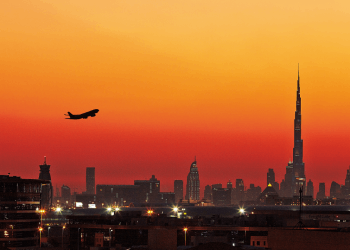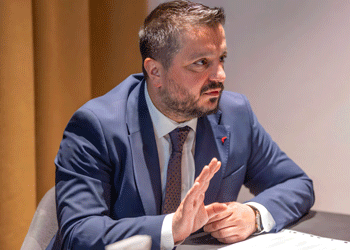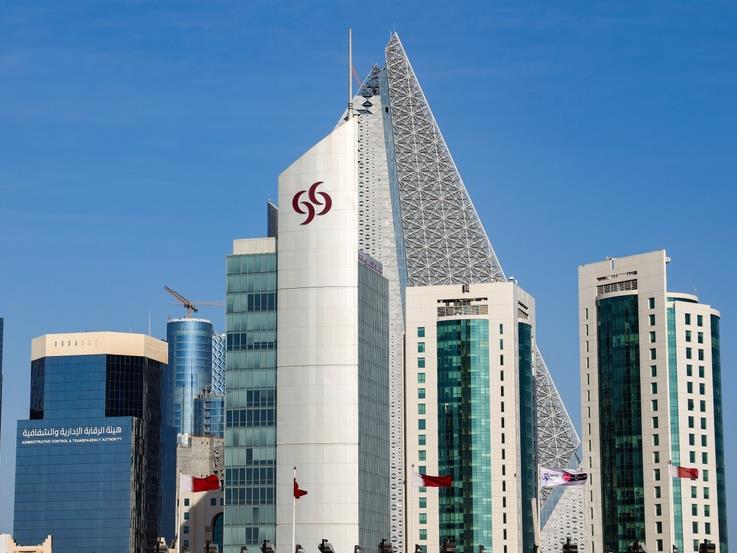Egypt gas project activity collapses amid energy crisis
27 February 2025

The total value of active Egyptian gas projects has fallen by 79% despite a steep decline in domestic gas output that has ramped up the need for costly imports.
At the start of 2019, the total value of active gas projects in Egypt was $41.5bn. This has now sunk to $8.6bn, according to data from regional project tracker MEED Projects.
 Despite the billions of dollars of investment that has been sunk into upstream projects in Egypt’s gas sector in recent years, production has been dropping after it peaked in 2021, according to the Energy Institute’s Statistical Review of World Energy.
Despite the billions of dollars of investment that has been sunk into upstream projects in Egypt’s gas sector in recent years, production has been dropping after it peaked in 2021, according to the Energy Institute’s Statistical Review of World Energy.
In 2021, Egypt produced 67.8 billion cubic metres (bcm) of gas. This fell to 64.5 bcm in 2022 and 57.1 bcm in 2023.
In May 2024, Egypt’s domestic gas output hit a six-year low, down by about 25% from its 2021 peak.
Declining domestic production has led to a severe energy shortage in Egypt.
Last year, the North African country had to resort to load-shedding to keep its grid functioning amid a lack of gas supply and rising demand, while the deepening energy crisis strained Cairo’s budget as it grappled with a heavy subsidies bill.
In the past 12 months, Gulf countries have had to help Egypt finance liquefied natural gas (LNG) imports worth billions of dollars to try and ease the country’s crisis.
Egypt had planned to become a regional gas hub and a major exporter after Italy’s Eni discovered the Zohr offshore field in 2015.
When Zohr started production in 2017, Egypt’s oil and gas ministry said that the field would produce 2.7 billion cubic feet a day (bcf/d) until 2039, but after rising to a peak at 3.2 bcf/d in 2019 output fell to just 1.9 bcf/d in the first half of 2024.
Production outlook
The collapse in the total value of gas projects in Egypt does not bode well for future domestic gas production – and signals that the country may remain reliant on costly gas imports for some time to come.
In addition, many of Egypt’s biggest active gas projects remain at the study stage with significant uncertainty about when execution will start and new production will be brought online.
A total of $5.1bn of all of Egypt’s active gas projects are currently in the study stage, making up 60% of active gas projects in the country.
Meanwhile, 12% of active gas projects are at the bid evaluation stage and 27% are currently under execution.
Last year, the Egyptian Natural Gas Holding Company launched an international bid round for the exploration and exploitation of natural gas and crude oil across 12 blocks in the Mediterranean and Nile Delta, as part of an initiative to try to boost production.
The 12 blocks were comprised of 10 offshore blocks and two onshore blocks.
While this initiative is promising, it is expected that Egypt’s efforts to attract bidders could be held back by recent problems with prompt payments to international oil companies (IOCs).
The Egyptian General Petroleum Corporation (EGPC) has accrued arrears to IOCs, estimated at $4bn-$5bn.
These debts have arisen due to a combination of foreign exchange shortages, as well as other structural issues, including declining domestic gas production, rising domestic consumption that limits gas export opportunities, and increased subsidies provided by EGPC to the electricity sector.
While gas project activity has plummeted since the start of 2019, oil project activity has seen a slight uptick, according to MEED Projects.
At the beginning of 2019, the total value of all active oil projects in Egypt was $15.2bn. As of 11 February 2024, this had risen by 15% to $17.6bn.
Economic issues are expected to hamper the development and execution of projects in the oil and gas sectors in 2025.
Inflation is rising, the Egyptian pound is continuing to lose value and millions of Egyptians are grappling with a cost-of-living crisis.
Inflation stood at 24% in December 2024 and Egypt’s debt-to-GDP ratio remains high, at 89% for the 2023-24 fiscal year.
The low value of the Egyptian pound is likely to cause significant problems to those that want to execute large-scale projects in Egypt’s oil and gas sectors, as it is likely to increase the cost of importing raw materials and equipment.
In December, the European Commission announced a plan to disburse €1bn ($1.05bn) in loans to help Egypt cover part of its financing needs for the fiscal year 2024-25 and “ensure macroeconomic stability”.
Financial support has also been provided by the IMF, the World Bank and the UAE.
However, with Egypt’s perilous economic situation hampering project development and a failure to execute strategic projects constraining economic growth, it is possible that the North African country will be reliant on significant assistance from its foreign partners for energy imports for some time to come.
MEED’s March 2025 special report on Egypt includes:
> COMMENT: Egypt battles structural issues
> GOVERNMENT: Egypt is in the eye of Trump’s Gaza storm
> ECONOMY: Egypt’s economy gets its mojo back
> OIL & GAS: Egypt gas project activity collapses amid energy crisis
> POWER & WATER: Egypt’s utility projects keep pace
> CONSTRUCTION: Coastal city scheme is a boon to Egypt construction
Exclusive from Meed
-

-
 Turkish Airlines plans further growth
Turkish Airlines plans further growth1 July 2025
-

-

-
 Levant states wrestle regional pressures
Levant states wrestle regional pressures1 July 2025
All of this is only 1% of what MEED.com has to offer
Subscribe now and unlock all the 153,671 articles on MEED.com
- All the latest news, data, and market intelligence across MENA at your fingerprints
- First-hand updates and inside information on projects, clients and competitors that matter to you
- 20 years' archive of information, data, and news for you to access at your convenience
- Strategize to succeed and minimise risks with timely analysis of current and future market trends

Related Articles
-
 Dubai South real estate faces airport noise concerns
Dubai South real estate faces airport noise concerns1 July 2025
 Commentary
Commentary
Yasir Iqbal
Construction writerThe AED128bn ($35bn) expansion of Al-Maktoum International airport (DWC) in Dubai South has reignited investor interest in the surrounding real estate market since its announcement last year. The scale of the project – set to transform DWC into the world’s largest airport by capacity by 2050 – has created a wave of optimism among developers and buyers alike.
That optimism is already reflected in the numbers. According to a recent report by real estate firm Betterhomes, total property sales in Dubai South reached AED16bn in just the first five months of this year – surpassing the AED15bn recorded in all of 2024.
Property prices in the area have risen by an average of 25% since the airport expansion was announced. Developers have moved swiftly to capitalise on the momentum, and price forecasts are optimistic, pointing to a potential rise in the short term.
However, amid the development buzz lies a critical and often overlooked concern: noise pollution.
With DWC projected to handle 130 million passengers annually by 2032 in its first phase alone, the scale – and the noise – will surpass that of DXB
Airports are indisputable engines of economic growth. They generate employment, boost connectivity and drive commercial development. Yet, for residential areas in close proximity, the long-term impact of aircraft noise can be significant – and detrimental.
Lessons from around Dubai International airport (DXB) offer a cautionary tale. Neighbourhoods such as Mirdiff and Deira, which lie directly under flight paths, frequently experience noise levels exceeding 80 decibels, according to data from Noise Map. These levels are associated with sleep disruption, irritability and even long-term health risks.
With DWC projected to handle 130 million passengers annually by 2032 in its first phase alone, the scale – and the noise – will surpass that of DXB.
Globally, major urban centres have responded to this challenge through strategic urban planning. In London, Heathrow’s surrounding neighbourhoods are tightly regulated with noise contours shaping planning policy. In Paris, Charles de Gaulle Airport is buffered by industrial zones and business parks, while Schiphol in Amsterdam maintains a significant distance between runways and residential districts. These cities offer valuable lessons in balancing airport growth with community wellbeing.
In Dubai South, the conversation is just beginning. Some residents in Emaar South and Dubai South communities have taken to online forums, noting that while current noise levels are tolerable with soundproof windows, this may change significantly once full airport operations commence. One user described the noise as “faint but noticeable”, while another warned: “Once the airport is fully functional, expect a lot of noise and possibly vibrations too.”
To ensure long-term liveability, developers and urban planners must take a proactive approach. Encouragingly, current residential projects in Dubai South have been sited more than 4 kilometres from the DWC runways and, more importantly, outside the direct flight path – mitigating some of the future noise impact.
Whether Dubai South evolves into a thriving, sustainable urban community or a transit-centric logistics zone will depend on how well these environmental factors are addressed. Investment appetite may be high today, but enduring value will require more than just proximity to an airport – it will depend on the quality of life that surrounds it.
https://image.digitalinsightresearch.in/uploads/NewsArticle/14170573/main.png -
 Turkish Airlines plans further growth
Turkish Airlines plans further growth1 July 2025
 This package on UAE-Turkiye relations also includes:
This package on UAE-Turkiye relations also includes:> UAE-Turkiye trade gains momentum
> Turkiye’s Kalyon goes global
> UAE-Turkiye financial links strengthen

With a network covering 30 more countries than its closest competitor, Turkish Airlines has been recognised by Guinness World Records for the most countries flown to by an airline since 2012. “Over the past two decades, Turkish Airlines has experienced rapid expansion, becoming one of the world’s most recognised airlines and the largest carrier in terms of destinations served,” says Erol Senol, vice-president of sales at Turkish Airlines.
The airline’s growth has meant it has become a competitor for the major Gulf carriers such as Emirates, Qatar Airways and Etihad. Senol says the growing aviation market offers opportunities for all carriers.
“The global centre of aviation is moving from the west to the east,” he says.
“This change is advantageous for all regions and carriers, provided there is the commitment to serve more effectively.”
 Extending reach
Extending reachLike the airlines in the Gulf, Turkish Airlines is based in a strategically important geographic location. “Istanbul is within a three-hour flight distance to 78 cities in 41 countries, making it a central hub for connections between Europe, Asia and Africa,” says Senol.
Since 2019, the airline has also been based at one of the world’s largest airports, Istanbul Grand airport (IGA), which has enabled it to continue growing.
“The transition to Istanbul Grand airport has marked a new era for Turkish Airlines, enabling the company to sustain its ambitious growth trajectory,” says Senol.
“Approximately 80% of its capacity is dedicated to Turkish Airlines, offering the airline the operational flexibility and technological support required to manage large-scale passenger and cargo flows.”
The congestion and capacity limitations that previously constrained operations at Ataturk airport were effectively resolved through this relocation.
“Aircraft movement capacity increased from 70 per hour at Ataturk to 80 at the initial stage of Istanbul airport, eventually reaching 120 movements an hour with the commissioning of the third runway. This has significantly reduced aircraft waiting times from 5% to below 1%, improving both punctuality and fuel efficiency,” he adds.
IGA’s larger footprint, which Senol says is “seven times larger than Ataturk airport” has also enhanced passenger services and facilities, helping to improve customer satisfaction and streamline operations.
Turkish Airlines has also increased its annual cargo handling capacity from 1.2 million tons at Ataturk to 2.5 million tonnes at IGA, with projections of reaching 5-6 million tonnes as the airport develops further. “Turkish Airlines has advanced from ninth place in 2018 to third place in 2025 in global air cargo traffic rankings,” says Senol.
Supporting the cargo business is Turkish Cargo’s airport facility, SmartIST, which began operations in February 2022. In 2024, cargo volumes at SmartIST increased by 20% compared to 2023, reaching 1.99 million tonnes. Based on freight tonne kilometres, Turkish Cargo says its market share has reached 5.7%, ranking it third globally. Market share rose to 5.8% in the first quarter of 2025.
A second phase of expansion will further enhance Turkish Cargo’s operations capacity, allowing it to handle up to 4.5 million tonnes annually. The long-term target is to reach 3.9 million tonnes of cargo by 2033.
The relocation of Turkish Airlines’ operations to IGA presented many challenges.
“The relocation project involved extensive pre-planning and meticulous attention to detail,” says Senol.
One of the key challenges was maintaining uninterrupted flight operations during the transition. With real-time monitoring and contingency planning, Turkish Airlines completed the transfer within 33 hours.
The transition to Istanbul Grand airport has marked a new era for Turkish Airlines, enabling the company to sustain its ambitious growth trajectory
Erol Senol, Turkish AirlinesFuture growth
With major airport projects planned at other hubs, Senol offers some advice on how to ensure a seamless transition of operations. “Airlines should invest in full-scale simulations and contingency rehearsals well before the actual move, including load testing IT systems, coordinating logistics and stress-testing operational workflows,” he says.
“Success hinges on strong coordination across departments – operations, IT, cargo, ground services, human resources, safety and more. Turkish Airlines created interdisciplinary task forces and embedded decisionmakers in each operational unit to allow for real-time problem solving during the transition.
“A relocation isn’t just physical – it’s digital,” he notes. “Turkish Airlines used the move to accelerate digital transformation: implementing contactless systems, integrating cargo automation and upgrading passenger services. Airlines should use relocation as a catalyst to modernise infrastructure and adopt scalable technologies.”
Another factor is having room to grow. “Airlines should ensure their new base is not just sufficient, but expandable,” Senol adds.
By 2033, Turkish Airlines aims to serve 171 million passengers across 400 destinations with a fleet of 813 aircraft. “Our strategic plan is built on an annual average growth rate of 7.6%,” he says.
Turkish Airlines currently operates 481 aircraft, comprising 134 wide-body and 347 narrow-body planes. The airline has also placed orders for 355 new Airbus aircraft – 250 A321 Neos and 105 A350s – to support its growth strategy.
https://image.digitalinsightresearch.in/uploads/NewsArticle/14178357/main.gif -
 Qatar records largest local-currency bank bond issuance
Qatar records largest local-currency bank bond issuance1 July 2025
Register for MEED’s 14-day trial access
Qatar-based Commercial Bank has completed a QR500m ($137m) senior unsecured bond sale, marking the largest local-currency issuance by a Qatari bank to date.
The three-year bonds, priced with a 4.9% coupon, were issued under the bank’s Euro Medium Term Note (EMTN) programme. The notes are listed on Euronext Dublin. DBS Bank and Standard Chartered acted as joint lead managers.
The deal attracted strong demand from both regional and international investors, as lenders across the Gulf continue to diversify their funding bases amid high interest rates, Commercial Bank said in a statement.
The issuance comes as Qatar’s domestic debt market gains momentum, with banks seeking to tap liquidity in both riyal and hard currency formats.
Commercial Bank is rated A2 by Moody’s, A– by S&P, and A by Fitch, all with stable outlooks. The lender reported a net profit before tax of QR704.3m for Q1 2025, down from QR801.6m in the same period last year.
https://image.digitalinsightresearch.in/uploads/NewsArticle/14177167/main3557.jpg -
 New Murabba signs MoU for project delivery solutions
New Murabba signs MoU for project delivery solutions1 July 2025
Saudi Arabia’s New Murabba Development Company (NMDC) has signed a memorandum of understanding (MoU) with South Korea’s Naver Cloud Corporation to explore technological solutions for delivering its 14 square-kilometre (sq km) New Murabba downtown project.
New Murabba CEO Michael Dyke signed the agreement earlier this week during the company’s Investment and Partnership Forum in Seoul.
According to an official statement: “The three-year agreement covers exploring innovative technology and automation to support the delivery of New Murabba, including robotics, autonomous vehicles, a smart city platform and digital solutions for monitoring construction progress.”
NMDC is in Seoul to examine technological offerings, assess financing options and showcase the investment opportunities available for the New Murabba downtown development.
The statement added that the excavation works for The Mukaab, the centrepiece of the overall development, have now been completed.
The Mukaab is a Najdi-inspired landmark that will be one of the largest buildings in the world. It will be 400 metres high, 400 metres wide and 400 metres long. Internally, it will have a tower on top of a spiral base and a structure featuring 2 million square metres (sq m) of floor space designated for hospitality. It will feature commercial spaces, cultural and tourist attractions, residential and hotel units, as well as recreational facilities.
Downtown destination
The New Murabba destination will have a total floor area of more than 25 million sq m and feature more than 104,000 residential units, 9,000 hotel rooms and over 980,000 sq m of retail space.
The scheme will include 1.4 million sq m of office space, 620,000 sq m of leisure facilities and 1.8 million sq m of space dedicated to community facilities.
The project will be developed around the concept of sustainability and will include green spaces and walking and cycling paths to promote active lifestyles and community activities.
The living, working and entertainment facilities will be developed within a 15-minute walking radius. The area will use an internal transport system and will be about a 20-minute drive from the airport.
The downtown area will feature a museum, a technology and design university, an immersive, multipurpose theatre, and more than 80 entertainment and cultural venues.
https://image.digitalinsightresearch.in/uploads/NewsArticle/14177612/main.jpg -
 Levant states wrestle regional pressures
Levant states wrestle regional pressures1 July 2025
 Commentary
Commentary
John Bambridge
Analysis editorThe Levant countries of Jordan, Lebanon and Syria are all in various degrees of distress, and collectively represent the Israel-Palestine-adjacent geography most severely impacted by that conflict, including in the latest phase initiated by Israel’s attack on Iran. In all three cases, however, recent developments have provided tentative hope for the improvement of their political and economic situations in 2025.
In the case of Lebanon, still reeling from Israel’s invasion and occupation of the country’s southern territories in retaliation for Hezbollah’s missile attacks on northern Israeli cities, the hope has come in the form of the country’s first elected president since 2022, and a new prime minister.
The task before both leaders is to stabilise a deeply fragile political and economic situation while avoiding further degradation to Lebanon’s weakened state capacity. If the country can ride through present circumstances to the upcoming parliamentary elections in May 2026, the possibility could also emerge for a more comprehensive shake-up of its stagnant politics.
In civil war-wracked Syria, the toppling of the Bashar Al-Assad government in December and the swift takeover by forces loyal to Ahmed Al-Sharaa have heralded a political transition – even if it is not the secular one that Syria’s population might have once hoped for.
The new president has already made progress in reaching agreements for the rollback of EU and US sanctions and an influx of foreign investment that his predecessor could only have dreamt of securing. This opens the door to a future of economic recovery for the country.
The reopening and reconstruction of the Syrian economy also has the potential to benefit the entire region, by rebooting trade and providing growth opportunities.
For Jordan, the recent conflict in Israel and the occupied Palestinian territories has hit tourism hard, while also pitching the country’s anti-Israel street against its US-allied government. Washington’s threats to cut aid and to raise tariffs on Jordan have added to the political strain on the country, and this has only been staved off by in-person overtures by King Abdullah II to the US government.
The outbreak of hostilities between Israel and Iran has only worsened the economic climate for Jordan, with both Israeli jets and Iranian munitions frequenting Jordanian airspace and providing a constant reminder of how close the country is to being dragged into regional unrest. Yet Jordan has avoided conflict to date, and the country’s GDP growth is expected to rise modestly in 2025 as an increase in exports and projects activity stimulates the economy, despite the wider regional headwinds.
The overall picture for this region is therefore one of tentative recovery from recent shocks, ripe with potential for a better path forward as the Levant rebuilds and works together to overcome the challenges that have so long afflicted the region.

MEED’s July 2025 report on the Levant includes:
> COMMENT: Levant states wrestle regional pressures
JORDAN
> ECONOMY: Jordan economy nears inflection point
> GAS: Jordan pushes ahead with gas plans
> POWER & WATER: Record-breaking year for Jordan’s water sector
> CONSTRUCTION: PPP schemes to drive Jordan construction
> DATABANK: Jordan’s economy holds pace, for nowLEBANON
> ECONOMY: Lebanon’s outlook remains fraughtSYRIA
> RECONSTRUCTION: Who will fund Syria’s $1tn rebuild?To see previous issues of MEED Business Review, please click herehttps://image.digitalinsightresearch.in/uploads/NewsArticle/14122966/main.gif

